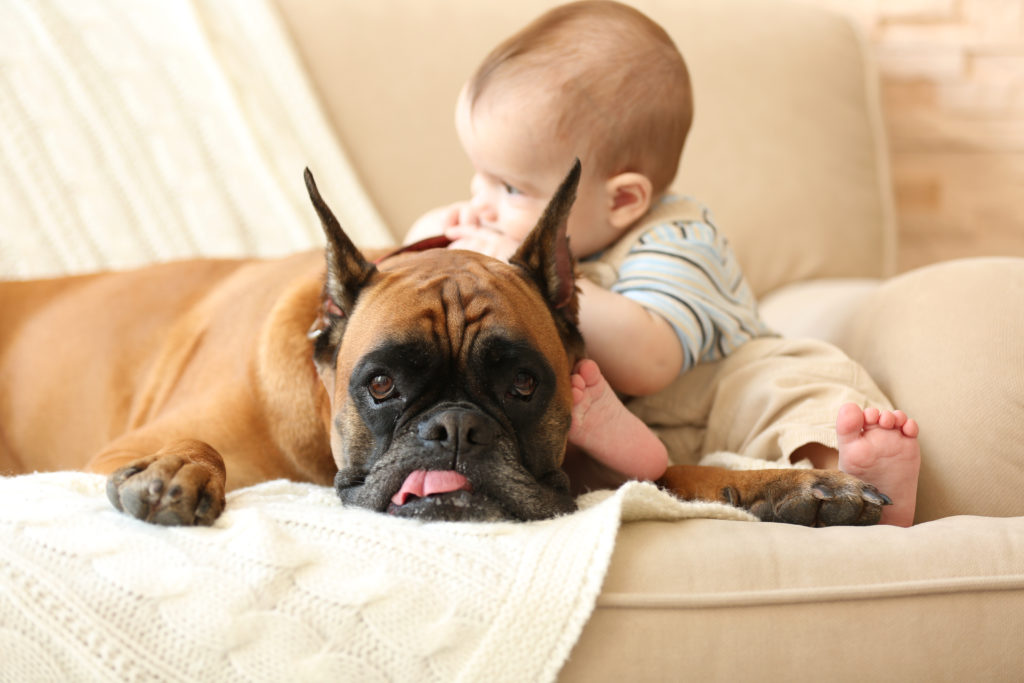The arrival of a new member of the family is a joyous occasion. However, as we all know, it can also be a very stressful time.
Sleepless nights, tiredness, new routines and unprecedented levels of mess will upset even the most calm and collected household. And if we find our new baby stressful, imagine how our pets must be feeling! With that in mind, check out our tips for preparing your dog for the arrival of a new baby.

1. Start Early
The work begins as soon as you find out about your pregnancy. Teaching your dog some basic obedience skills will help you to manage its behaviour when the baby arrives. If you need some help, there are plenty local dog classes around, either as a group, or as one-on-one sessions. As your pregnancy progresses, gradually introduce your dog to the new sights, sounds and smells that it will start to encounter once the baby comes home, and, more importantly, to associate these new sensations with rewards.
One or two months before the baby arrives, anticipate the changes that will happen to your dog’s usual routine. Start initiating those changes now, so it is not a shock to the system when the baby arrives. These could include altering feeding times and walking patterns, beginning to take short naps in the day, as you might when the baby arrives, and generally making the changes in advance. The same goes for teaching new habits and disciplines you wish to initiate for when the baby arrives, such as stopping the dog from jumping up or on furniture.

2. Special Skills
Hand Targeting – This is a skill that will come in very handy. It involves teaching your dog to follow your finger with its nose, so it knows exactly where to sniff. This will allow you to control where and when the dog is allowed to sniff the baby.
“Go Away!” – There will be times when you will need your dog to be absent when you are caring for your new baby, or to remove itself from a situation which may be stressing it out. For example, if the baby is crawling towards the dog and the dog appears uncomfortable, the “Go Away” command gives your dog permission to remove itself. It is important that the dog’s behaviour and presence is managed in a balanced, safe way. You teach the “Go Away” command by showing your dog a treat, then tossing it a few feet away whilst saying the command. Repeat this many times. Progress to uttering the command before throwing the treat, pretending to throw the treat as you do so. When the dog moves in the direction of your gesture, react positively (“Yes!”) and then immediately throw the treat four or five feet away, in the direction the dog started to move.
Play Fetch – This is a good game that will prepare your dog for a fun, safe interaction with your baby. Teaching your dog to fetch a toy is enjoyable and easy

3. Handling and Movement
Let’s face it, small children don’t understand how to handle dogs. To prepare your dog for this inevitability, practice acting out the sort of grabbing, poking and pushing the dog is likely to encounter from the child. Simultaneously offer rewards, so the dog learns that good things happen when these actions take place.
Remember to remain gentle, you don’t want to hurt your dog. As you enact the behaviour (e.g. grabbing your dog’s ear) combine it with a cheery voiced phrase, like “Ooh, what was that?” Practice this several times every day, using especially exciting treats such as cheese, and build up intensity as the dog becomes accustomed. You should also practice crawling in front of your dog, so it begins to see this as a normal human behaviour before the baby starts doing it.
Most of all, it is absolutely vital that you do not sideline your dog in light of the new baby. Your dog is part of the family, and if it feels left out, resentment will build up and could lead to dangerous situations. Your dog should be included as part of the family, always. It should be allowed to interact with the baby as early as possible, to understand that the baby is part of the ‘pack’, and also that it has a higher place within that pack than the dog.
Remaining sensitive to your dog’s needs, even during this time of great upheaval, will serve the whole family well in the long term, and keep your dog feeling as secure and loved as they always have been.
Want to see more topics? Go back to all Articles about Pets